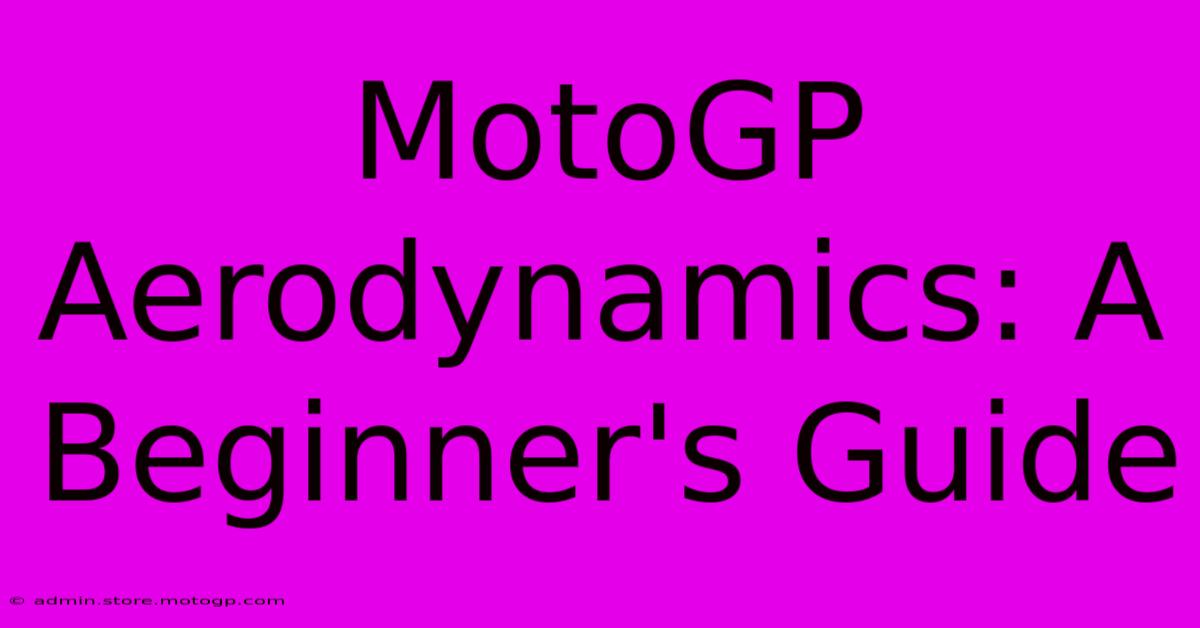MotoGP Aerodynamics: A Beginner's Guide

Table of Contents
MotoGP Aerodynamics: A Beginner's Guide
MotoGP racing is a thrilling spectacle of speed, skill, and technology. While rider talent is paramount, the cutting-edge technology employed, particularly in aerodynamics, plays a crucial role in determining race outcomes. This beginner's guide will unravel the complexities of MotoGP aerodynamics, explaining its importance and impact on performance.
Understanding the Importance of Aerodynamics in MotoGP
Aerodynamics, the study of air's motion and its effects on objects, is critically important in MotoGP. At speeds exceeding 200 mph (320 km/h), even slight improvements in aerodynamic efficiency can translate into significant gains in lap times. The primary aerodynamic challenges faced by MotoGP bikes are:
- Drag Reduction: Minimizing air resistance is crucial for achieving higher top speeds and better acceleration. The less air pushing against the bike, the faster it can go.
- Downforce Generation: Generating downforce, or the force pushing the bike towards the track, is equally vital. This enhances stability at high speeds, allowing riders to lean into corners with greater confidence and maintain higher cornering speeds. This is achieved without significantly increasing drag.
Key Aerodynamic Components of a MotoGP Bike
Modern MotoGP bikes are equipped with sophisticated aerodynamic devices designed to optimize both drag reduction and downforce generation. These include:
1. Fairings:
The fairings, the bodywork surrounding the engine and other components, are meticulously designed to streamline airflow. Their shape is crucial in minimizing drag and directing airflow effectively. Computational Fluid Dynamics (CFD) simulations play a key role in optimizing fairing design.
2. Wings:
These are the most visually striking aerodynamic components. They are strategically placed to generate downforce, particularly at the front and rear of the bike. The design of these wings—their size, shape, and angle—is constantly being refined to improve their effectiveness. Different tracks require different wing configurations.
3. Winglets:
Smaller versions of wings, winglets are often integrated into the fairing and other components. They offer additional downforce with minimal added drag. Their placement and design are critical for optimal performance.
4. Aerodynamic Appendages:
This encompasses a variety of smaller aerodynamic elements, often added to fine-tune airflow and enhance specific aspects of performance, such as stability under braking or acceleration.
The Evolution of MotoGP Aerodynamics
Aerodynamics in MotoGP has evolved dramatically over the years. Early bikes were relatively basic, with simple fairings. However, as speeds increased, the importance of sophisticated aerodynamic solutions became undeniable.
The introduction of wings and winglets marked a significant turning point, allowing for dramatic increases in downforce. This led to an ongoing arms race, with manufacturers continuously innovating to develop more efficient and effective aerodynamic solutions. Regulations are frequently updated to control this.
The Impact on Rider Performance
Improved aerodynamics translate directly into enhanced rider performance:
- Higher Cornering Speeds: Increased downforce allows riders to lean further into corners without losing grip, resulting in faster lap times.
- Improved Stability: Better stability at high speeds gives riders more confidence and control, allowing them to push the bike harder.
- Enhanced Braking Performance: Aerodynamic downforce assists in braking stability, enabling later braking points and ultimately faster lap times.
- Greater Acceleration: Reduced drag leads to more efficient acceleration out of corners.
The Future of MotoGP Aerodynamics
The future of MotoGP aerodynamics promises even more sophisticated solutions. We can expect to see further refinements in wing and winglets design, along with the integration of new technologies and materials. The ongoing interplay between technological advancements and regulatory constraints will continue to shape the evolution of this crucial aspect of MotoGP racing. Expect to see continued innovation pushing the boundaries of speed and performance.
This beginner's guide provides a foundational understanding of the complexities of MotoGP aerodynamics. While the subject is nuanced and constantly evolving, this overview sheds light on its crucial role in shaping the thrilling spectacle we see on the track each weekend.

Thank you for visiting our website wich cover about MotoGP Aerodynamics: A Beginner's Guide. We hope the information provided has been useful to you. Feel free to contact us if you have any questions or need further assistance. See you next time and dont miss to bookmark.
Featured Posts
-
Cota Parking Map Your Comprehensive Guide
Feb 21, 2025
-
Experience The Intensity Race Bikes For Sale
Feb 21, 2025
-
What Time Is The Sprint Race Locally
Feb 21, 2025
-
Best Moto Gp Riders Records And Rivalries
Feb 21, 2025
-
Your Cota Track Day Adventure Starts Now
Feb 21, 2025
